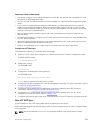
RSTP and VLT
VLT provides loop-free redundant topologies and does not require RSTP.
RSTP can cause temporary port state blocking and may cause topology changes after link or node
failures. Spanning tree topology changes are distributed to the entire layer 2 network, which can cause a
network-wide flush of learned MAC and ARP addresses, requiring these addresses to be re-learned.
However, enabling RSTP can detect potential loops caused by non-system issues such as cabling errors
or incorrect configurations. To minimize possible topology changes after link or node failure, RSTP is
useful for potential loop detection. Configure RSTP using the following specifications.
The following recommendations help you avoid these issues and the associated traffic loss caused by
using RSTP when you enable VLT on both VLT peers:
• Configure any ports at the edge of the spanning tree’s operating domain as edge ports, which are
directly connected to end stations or server racks. Disable RSTP on ports connected directly to Layer
3-only routers not running STP or configure them as edge ports.
• Ensure that the primary VLT node is the root bridge and the secondary VLT peer node has the
second-best bridge ID in the network. If the primary VLT peer node fails, the secondary VLT peer
node becomes the root bridge, avoiding problems with spanning tree port state changes that occur
when a VLT node fails or recovers.
• Even with this configuration, if the node has non-VLT ports using RSTP that you did not configure as
edge ports and are connected to other Layer 2 switches, spanning tree topology changes are still
detected after VLT node recovery. To avoid this scenario, ensure that you configure any non-VLT
ports as edge ports or disable RSTP.
VLT Bandwidth Monitoring
When bandwidth usage of the VLTi (ICL) exceeds 80%, a syslog error message (shown in the following
message) and an SNMP trap are generated.
%STKUNIT0-M:CP %VLTMGR-6-VLT-LAG-ICL: Overall Bandwidth utilization of VLT-ICL-
LAG (port-channel 25)
crosses threshold. Bandwidth usage (80 )
When the bandwidth usage drops below the 80% threshold, the system generates another syslog
message (shown in the following message) and an SNMP trap.
%STKUNIT0-M:CP %VLTMGR-6-VLT-LAG-ICL: Overall Bandwidth utilization of VLT-ICL-
LAG (port-channel 25)
reaches below threshold. Bandwidth usage (74 )VLT show remote port channel
status
VLT and IGMP Snooping
When configuring IGMP Snooping with VLT, ensure the configurations on both sides of the VLT trunk are
identical to get the same behavior on both sides of the trunk.
When you configure IGMP snooping on a VLT node, the dynamically learned groups and multicast router
ports are automatically learned on the VLT peer node.
VLT IPv6
The following features have been enhanced to support VLT on IPv6.
:
950
Virtual Link Trunking (VLT)


















